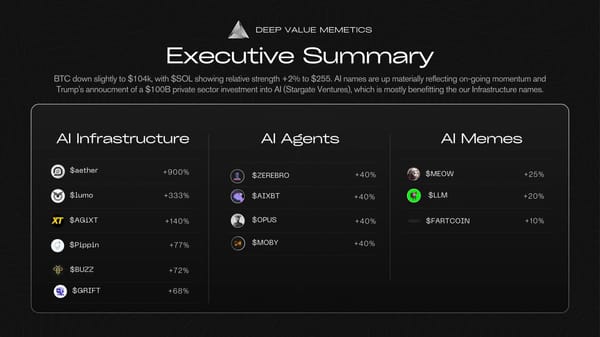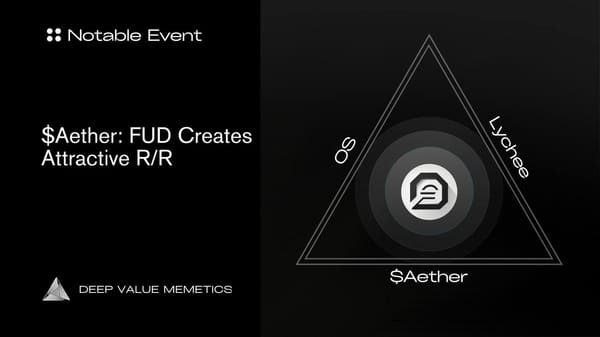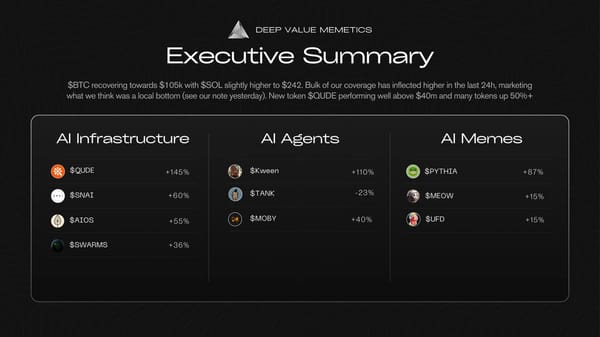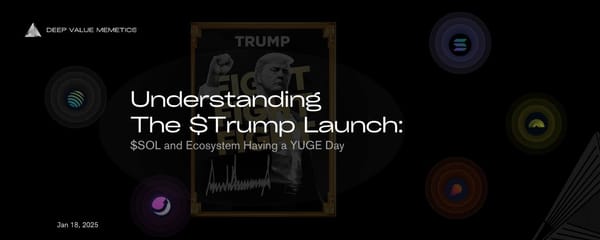DanteGPU: Unlocking Cost-Effective AI Computing Through Decentralized GPU Rentals

Note: this is a retroactive add to match X publication on (12/29/2024)
Quick Glance | New Token | $dGPU ($8.7M FDV) | @dantegpu Via @baturalpguvnc, @mehmetzsche, & @MuhammedAknc15
DVM View:
$dGPU (@dantegpu, DanteGPU) provides GPU rental for AI agents on Solana. We believe this is the first GPU market specifically for AI agents.
While Solana’s agents are behind $Virtual’s in terms of popularity thus far, we do think Solana could gain momentum in the long run.
We think GPU rental marketplaces could gain ground given GPU shortages and cost hurdles, and in building more powerful AI agents as the sector grows.
Team is doxxed, tokens are locked thru Q1. Valuation at ~$7m is comp’ing into a similar rental / GPU aggregation group of $NOS (@nosana_ai, $250m FDV), AKT (@akashnet_, $1.1b) and $IO (@ionet, $2.2b).
What is it? | A decentralized GPU rental platform for AI development
DanteGPU is a decentralized GPU rental platform designed specifically for AI developers, built on the Solana blockchain.
This project aims to democratize GPU Access by converting idle GPUs into revenue streams, DanteGPU allows owners to rent out their hardware while providing developers with cost-effective computing power for AI development.
Through its AI agent marketplace, the platform intelligently matches AI models with the most suitable GPU configurations based on user needs, thereby enhancing performance and reducing costs.
How Does It Work? | Blockchain for transparent exchange of GPUs, AI for pairing, predictive analytics for forecasting demand.
Users can rent GPUs from a network of providers. The platform uses blockchain to ensure secure, transparent transactions and GPU availability.
An automated system that, Analyzes user requirements, Recommends optimal GPU-AI model pairings using AI algorithms and machine learning techniques. Solana Pay for handling rental transactions.
Phantom Wallet for user authentication and payment processing. Anchor for smart contract development, which facilitates the decentralized aspects of the platform. Metaplex for NFT-based GPU ownership verification, ensuring that each GPU's ownership and rental rights are uniquely tracked.
The platform employs machine learning for Giza, ML-based resource optimization to manage GPU loads efficiently and Advanced automation and predictive analytics to forecast demand and optimize supply.
What is the Technology Stack? | Langchain for AI pipelines, Ollama for analysis, & Scikit-learn for predicting GPU performance
LangChain for managing AI pipelines. Ollama for model analysis. Scikit-learn for predicting GPU performance, aiding in the recommendation process.
Utilizes Solana for its high throughput and low transaction costs, ideal for microtransactions like GPU rentals. GitHub for code hosting, indicating active development and community contributions.
The system connects directly with Kuzco.xyz's GPU cluster network, efficiently allocating computational resources based on real-time availability and demand.
Implemented using natural language processing techniques, this module identifies and quantifies significant terms from the extracted URLs.
Powered by AI16Z DAO's toolkit, the platform intelligently distributes and manages AI agent tasks across the available GPU resources for optimal performance.
Team | Doxxed Experts
The team appears to be well-rounded, combining expertise in blockchain, AI, and software development, which is crucial for the project's success in an area where both cutting-edge AI application and blockchain technology are pivotal.
Comparison with others:
@DanteGPU leverages the Solana blockchain for decentralized GPU computing aimed at AI developers, emphasizing ease of deployment and potentially lower transaction costs, comparables such as $NOS focuses on creating a network operating system for decentralized computing, $AKT provides a broader, permissionless cloud marketplace with an emphasis on cost efficiency, while $IO and $RNDR target specialized markets, with $IO focusing on AI computing needs and $RNDR on high-end rendering services, both leveraging different blockchains like Ethereum for smart contract functionality.
Each platform varies in its approach to blockchain integration, with $NOS, $AKT, and $IO using various blockchains like Ethereum or their custom solutions, while $RNDR has been heavily associated with Ethereum for its decentralized rendering network.

Current Status and Future Goals:
The project is in its early stages, with active development ongoing, including UI enhancements and language support. The project targets for the next year are deployment of over 100 GPUs, achieving $5M in Annual Recurring Revenue, establishing international data centers, and Implementing advanced ML-based resource optimization and predictive analytics.
References:
CA: 7xUV6YR3rZMfExPqZiovQSUxpnHxr2KJJqFg1bFrpump
X profile: https://x.com/dantegpu
Web: https://dantegpu.com
GitHub: https://github.com/dante-gpu




